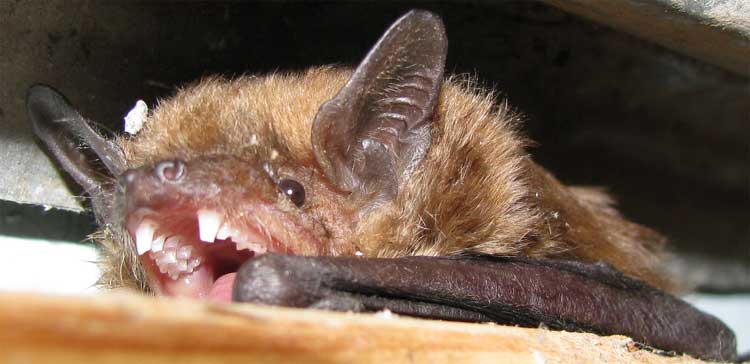Excerpts from Jim Conrad's
Naturalist Newsletter

from the July 28, 2008 Newsletter, issued from the forest near Natchez, Mississippi; elevation ~400ft (120m), ~N31.47°, ~W91.29°:
A BAT'S TEETH & TRAGUSES
The other day Karen noticed a little dark blob she hadn't noticed before wedged between the roof and some rafters. When she got real close she realized it was a bat, which delighted her. She came to get me, I got my camera, and you can see the resulting picture above.
One nice thing about that image is how well the teeth show up. Bat teeth I've seen before were sharp so I was surprised that this one's canines were so truncated. I'm guessing that this indicates an old bat. There's a nice page just on bat teeth at https://insider.si.edu/2011/02/for-chomping-insects-to-fruit-form-follows-function-in-bat-teeth/.
Another nice feature of the picture is that it shows the tragus. Among bats, traguses are leaflike structures arising in the exterior ear. Humans and other animals also have them, though not so well developed. A diagram showing where your tragus is at https://en.wikipedia.org/wiki/Tragus_(ear)).
The function of bat traguses isn't clear, but it's assumed that they help with echolocation. What is certain is that in bat identification traguses are very important, for traguses come in different relative sizes and shapes, and they can be sharp or rounded at their tips.
To see our bat's tragus look at the base of the ear- hole in the picture's center. Notice the item similar to a fleshy shark fin with the top of the fin glossy and bent toward the bat's nose. That's the tragus.
Even with such a fine picture and a good view of our bat's blunt tragus I couldn't definitively identify our bat using my Peterson field guide to the mammals. Therefore I checked into a bat forum on the Internet. A few hours after posting the above picture bat expert John in Pennsylvania had replied with a note that our bat, despite its small size, is the Big Brown Bat, EPTESICUS FUSCUS. That's a good species to know because it's one of the most widespread and common bats in North America, found throughout southern Canada and all of the US except most of Florida.
One bat-management professional on the Web writes that "99% of the bats that we remove from the living space of homes are Big Brown Bats."
from the July 20, 2003 Newsletter, issued from near Natchez, Mississippi:
BIG BROWN BATS
The first day I spent in the barn at my new location I was thrilled to see that we had bats here, too. With about 95% certainty I identified them as Big Brown Bats, EPTESICUS FUSCUS. A colony of about 15 roosted inside the barn where timbers came together forming the roof's ridgepiece. Those timbers were warped just enough to permit entry of the bats through the crevice between them.
During those first days while cleaning up the barn I made a lot of noise and moved many things around, and the bats began leaving. Maybe worse than me, however, was the heat. In late afternoon on sunny days the sun beats down on the barn's tin roof just an inch or two above the roost. Bats can be seen extending one wing through the slit below them trying to catch a cool breeze. Sometimes you see a line of little noses poking downward through the slit as they try to breathe fresh air. One day I found a dazed one on the concrete floor. I sprinkled water on him and fanned him, and he quickly got himself together and flew off. After that day all the bats were gone for a couple of weeks.
Nowadays a few individuals come and go but instead of trying to stay in their scorching crevice all day, on sunny afternoons they exit their hole and hang on timbers in full view. Sometimes they fly about in the barn before settling someplace, maybe trying to cool off. Once they've landed, sometimes I climb into the crossbeams and look at them from just two or three inches away. I'm tickled with these bats.
Big Brown Bats are among the species you'd expect in an old house or barn. Their species is one of the few among wild animals whose populations may have grown as human society has altered the landscape for its own purposes. Big Brown Bats are found over a very large area -- from southern Canada through North America, down through Central America, to extreme northern South America, and the West Indies. One reason for their success is that, as bats go, they are a bit tolerant of disruption and flexible in their behavior.
One neat feature of their behavior is that at this time of year mothers with their one or two babies gather in "maternity colonies," while the males roost alone or in small groups. I think I have hanging-loose males here. In nature it's nearly always the case that the most sophisticated beings produce few children but take good care of them, while it's the opposite for less sophisticated ones. The fact that Big Brown Bat mothers produce just one or two offspring tells me that my bats are uncommonly intelligent and complex creatures.